Among our unique GAC Specialty Polymer Mediums is a fabric painting medium named GAC 900. When combined with artist acrylics, the mixtures may be used to create wearable, launderable designs. The paints can be applied in multiple ways. This article provides mixing recipes, application techniques, heat-setting methods, and laundering instructions.
Why Use GAC 900?
Fabric painting on wearable garments is not a difficult process. Most artists – on purpose or by accident – have had acrylic paints stain their clothes. They quickly find out that it’s nearly impossible to remove dried paint from your clothes. So why use GAC 900 at all? For starters, while acrylics adhere readily to fabric, they are uncomfortably stiff, and after a few laundering cycles paint films tend to crack and flake. These same paints mixed with GAC 900 will become much more flexible, elastic, breathable and comfortable. Once the paints are mixed up, use them as you like, and complete the process by heat-setting, which fuses the paint into the fabric.
The fabric paint mixtures may be used on either natural or synthetic fabrics. Watch out for “waterproof” fabric, as it can prevent paints from holding fast onto the garment. These garments need to be pre-treated (usually by laundering with detergents) to remove the hydrophobic coatings before painting can commence.
MIXING UP FABRIC PAINTS
GAC 900 is intended for use with acrylic paint at a 1:1 ratio (equal parts GAC 900 to acrylic paint). However, some colors or applications may require the ratio to be adjusted to work properly for a desired application or desired look. Higher levels of GAC 900 also increase the “softness of hand” which is necessary when painting on delicate, thin fabrics like silk.
Once you reach the desired consistency, you’re ready to begin painting. Mixed paints can be stored in air-tight containers and used for several painting sessions. Avoid long-term storage because some paint mixtures may not remain stable over several weeks or months.
The three most useful paint lines for use on textiles are Heavy Body Acrylics, Fluid Acrylics, and High Flow Acrylics. Other paint lines may be used, but always test first to see how they handle and hold up during laundering. The “best” paint recipe ultimately depends on which paint provides the proper consistency. The table below will look at some common fabric painting applications and help decide where to begin.
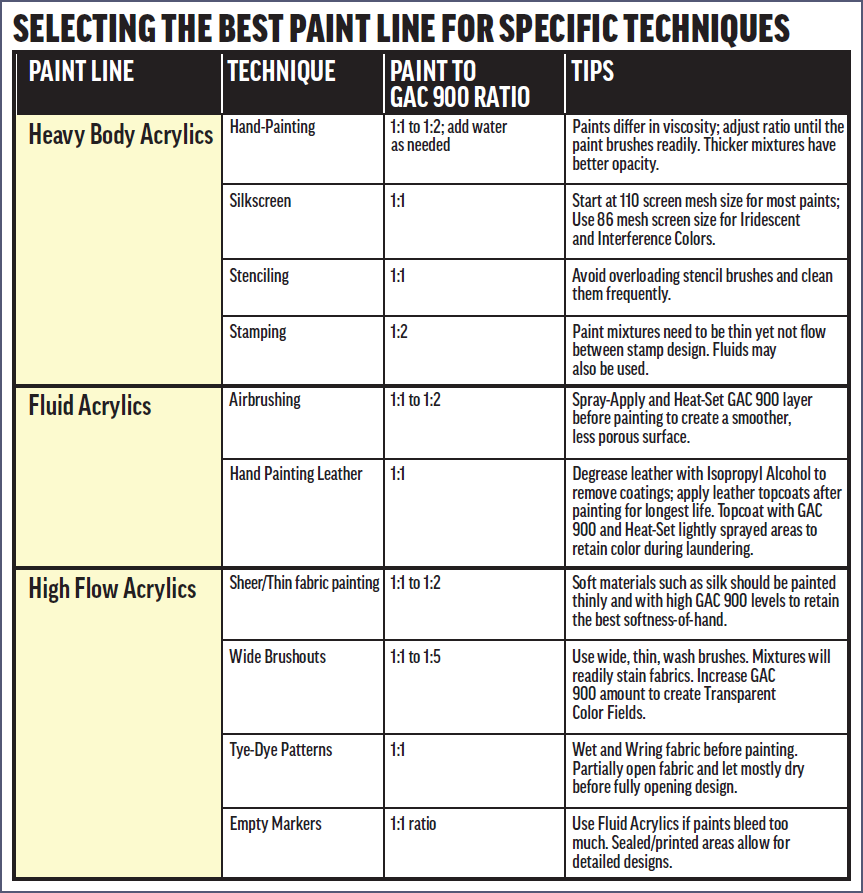
HEAVY BODY ACRYLICS AND GAC 900
Blends of Heavy Body Acrylics with GAC 900 yield a somewhat thick consistency suitable for hand-brushing, but it also works well for stenciling, stamping and even silkscreen printing. The 1:1 starting point ratio can be adjusted as needed, but bear in mind that using less GAC 900 results in stiffer paint layers prone to cracking, and higher levels of GAC 900 will be thinner but may “bleed” into the fabric. Otherwise, feel free to adjust the mixtures to work best for your needs.
If there are hard edges or crisp lines in your design, Heavy Body Acrylics are a solid choice. For a video about hard-edge painting on fabric, click here:
FLUID ACRYLICS AND GAC 900
Mixing with Fluid Acrylics creates thin, versatile fabric paints. The fluid consistency allows the paint to absorb more readily into the fabric, with the 1:1 ratio being useful for very fine details compared to Heavy Body Acrylics. If you’ve tested a few thinned Heavy Body Acrylics and found them to be too thick for your preference, then using Fluids is the next logical step. Note that GOLDEN acrylic paint lines are compatible and you can blend and use them for your painting needs.
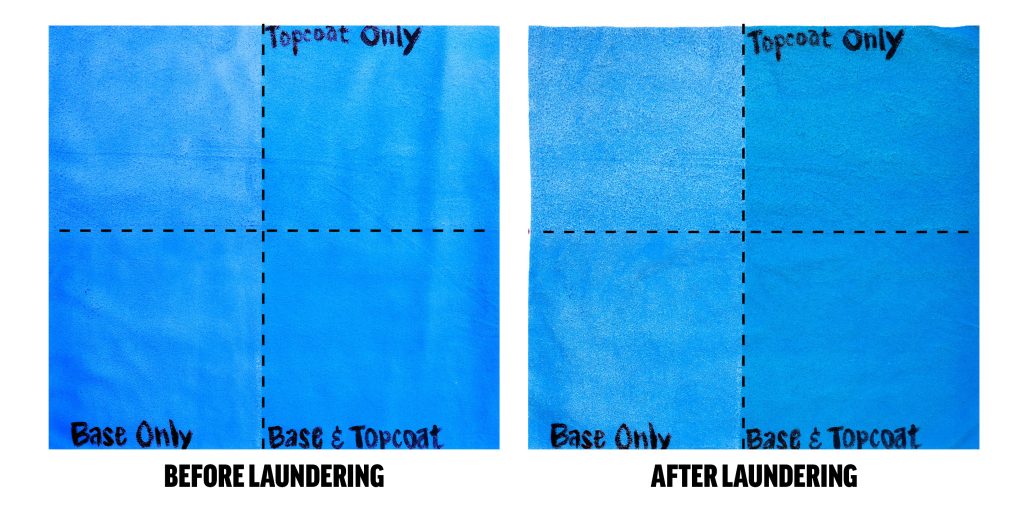
Right: Same airbrushed shirt, but first it was heat set, then laundered, resulting in color loss, especially when base and topcoat layers are not applied onto the shirt.
Using a base and top coat creates a smoother, softer painted fabric, ideal for fine details and smooth color gradations.
Fluid Acrylics generally work well for airbrushing, but spraying light applications often means more color is lost during at least the initial laundering cycle. This can be minimized by spraying GAC 900 directly over light sprays. To further help with retaining lightly sprayed color, apply a base coat of GAC 900 before painting and heat set with a clothes iron or heat press. The base coat also reduces surface absorbency and creates a smoother surface that positively impacts the painting process. Once the artwork is complete, apply a final topcoat of GAC 900 and heat set one more time (see test below).
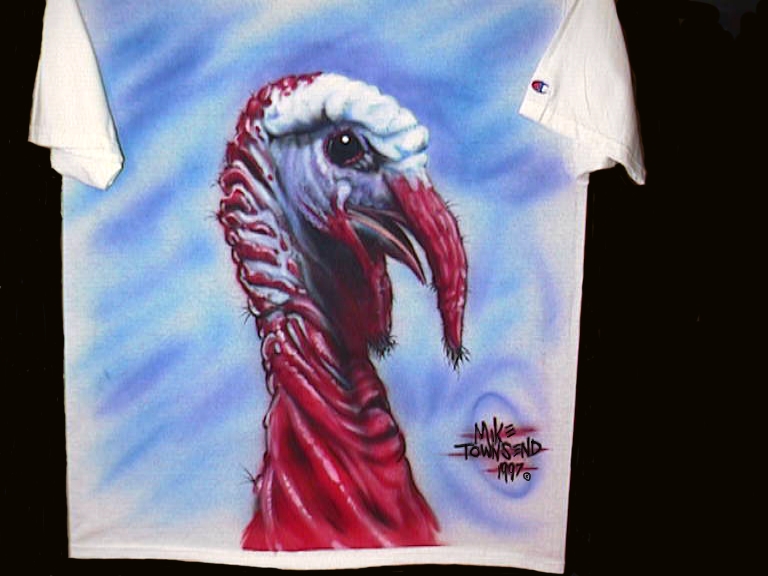
with lightly sprayed color.s
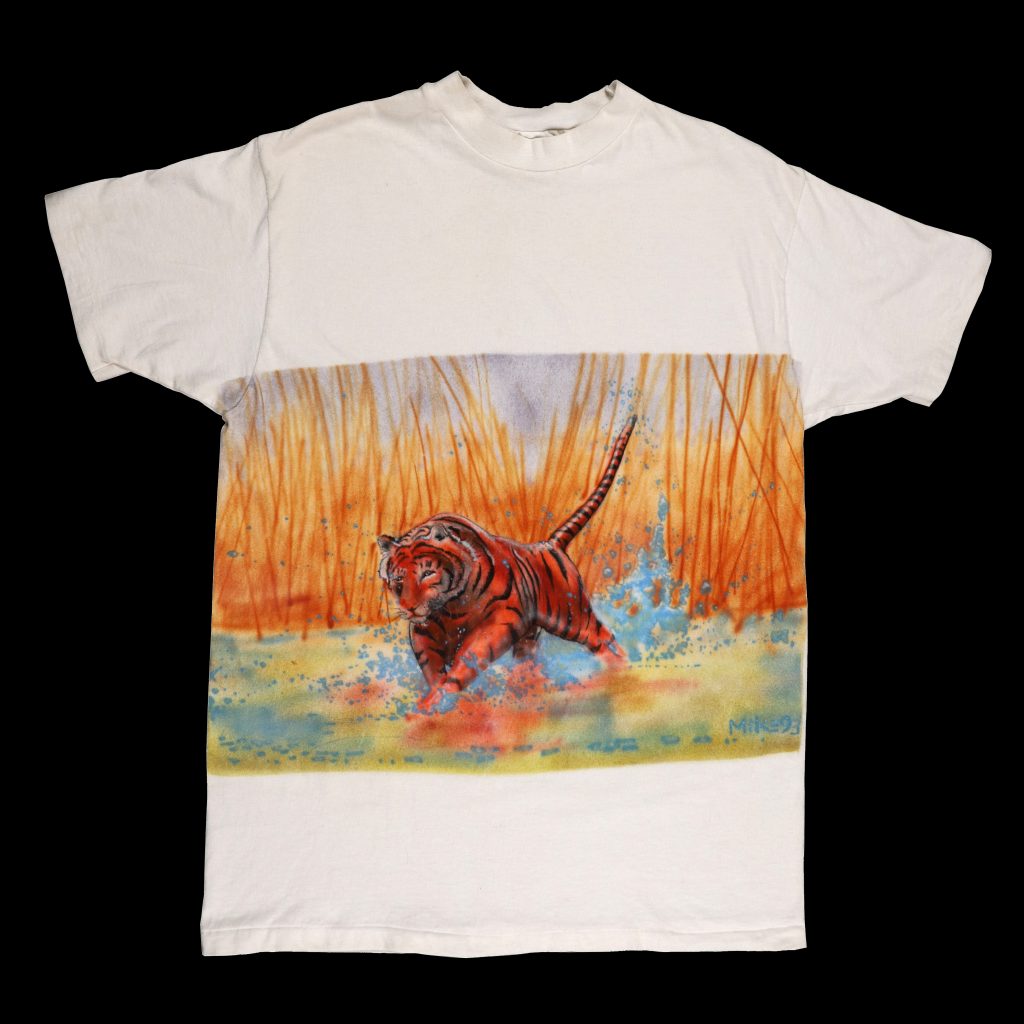
Painting on Leather
The Fluid Acrylics/GAC 900 combination is also an excellent choice when painting on leather. Leather is less porous than cotton/poly fabrics, producing more opacity and a more uniform application. Adjust the mixing ratio if more opacity is required. Some artists prefer an even thinner paint mixture, so exchange Fluid Acrylics with High Flow Acrylics. For more information, please refer to the article “Painting on Leather with Acrylics”.
HIGH FLOW ACRYLICS AND GAC 900
This ultra-thin combination behaves like watercolor washes and can be tricky to control at first. High-flow Acrylics work well for very thin fabrics, especially for staining techniques. Practice wash techniques are wonderful for color fields of overlapping color layers. Since this combination behaves like fabric dye, the paint soaks into and through the fabric.
Use in Refillable Paint Markers
High Flow Acrylics with GAC 900 can be used to create fabric paint markers. Start with the 1:1 ratio, then test how the markers behave on the textile surface. Markers provide good design control, but if you find that the mixtures bleed too much on the fabric, use thicker mixtures. Markers work well over smooth surfaces, such as screen prints and transfers.

TYE-DYE TECHNIQUES
A popular fabric painting application for thin paint mixtures is making “tye-dye, or “tie-dye” patterns. Once you create a shirt or two, feel free to modify or change the process to suit your style.
HEAT SETTING OPTIONS
All applications with GAC 900 should be heat set once they are air dry. The inherent tackiness that helps the medium fuse the paint into fabric will go away when properly heat set. The heat setting process can be as simple as tossing the garments into a home clothes dryer (on high for 40 minutes), a hair dryer, a clothes iron (set to the proper fabric setting), or for more consistent results, use a heat press.
The general rule is a lower temperature for a longer duration or a higher temperature for a shorter duration. Please make sure to follow the temperature limits for your type of fabric to avoid scorching the fabric. GAC 900 generally works on any type of fabric compatible with acrylic paints, especially organic fabrics like cotton, linen, leather, wool, silk and even synthetic fabrics like polyester.
Please take note that heat setting creates a temporary chemical reaction. This results in off-gassing low levels of formaldehyde. Therefore, ensure proper ventilation when heat setting. For more information and a chart about heat-setting specific materials, please refer to the GAC 900 Technical Information Sheet.

Heavy Body Acrylics were brush applied (Pyrrole Red) and silkscreened (Anthraquinone Blue), and
Fluid Acrylics were airbrush applied (Chromium Oxide Green) onto cotton fabric.
HOW TO MAXIMIZE THE LIFE OF PAINTED GARMENTS
After the paint has been properly heat set, the garment is now ready to wear. Caring for these pieces keeps the imagery and the garment looking good for years to come. This is wearable artwork, and if you wash it with strong detergents and coarse fabrics like jeans and towels, the design can fade due to fabric wear and pilling.
Provide the owner with the following care suggestions:
- Handwashing and then drip-drying is the best way to keep the clothing and painted designs looking their best.
- If machine washing, turn the garment inside out before tossing it in.
- Use delicate and gentle cycles, with gentle, enzyme-based fabric detergents.
- Wash with cool water and dry at medium dryer heat levels.
- Don’t overload the machines.
- Avoid laundering with coarse garments like blue jeans and towels.
- Follow a garment’s instructions tag as the default laundering process.
A WORD OF ENCOURAGEMENT
Don’t be discouraged by the level of detail in this article. Fabric painting with GAC 900 is a very easy process! Start with a couple of colors and eyeball around a 1:1 ratio. Practice on a couple of older tee shirts. Paint your favorite saying or try some loose abstract designs. After you have a couple of practice items just toss them into a home clothes dryer on high for an easy and safe way to heat-set the paints. Driers are vented so that the fumes go outside. Then wear them and see how they hold up. As always, let us know if you have any questions at [email protected], or leave a comment below this article.
REFERENCES
https://www.screenprinting.com/pages/screen-printing-mesh-size-information
https://galaxy-press.com/heat-press-guide-temperature-and-time-settings/
https://www.sunrise-metal.com/silk-screen-printing/
https://www.rd.com/article/how-to-de-pill-sweaters/
About Michael Townsend
View all posts by Michael Townsend -->Subscribe
Subscribe to the newsletter today!

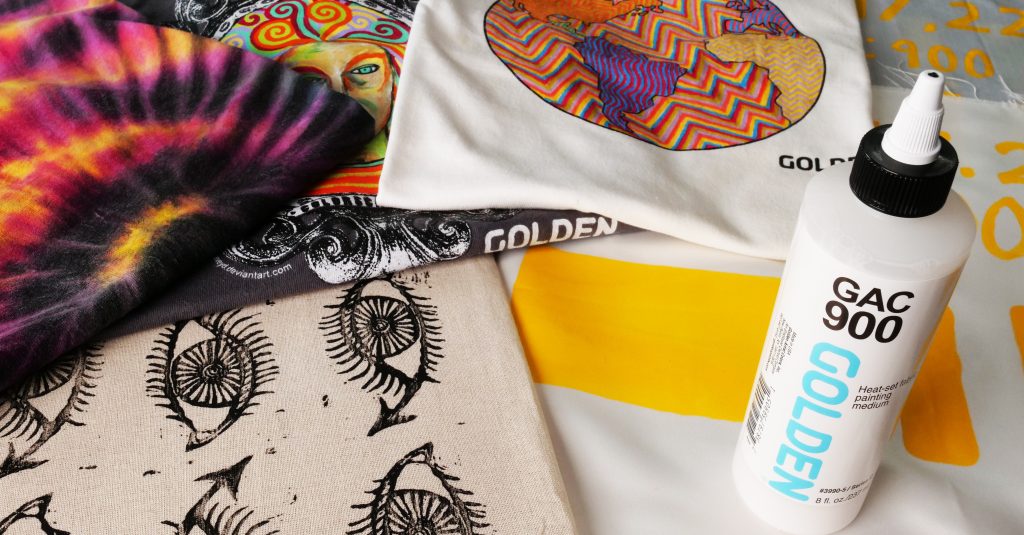
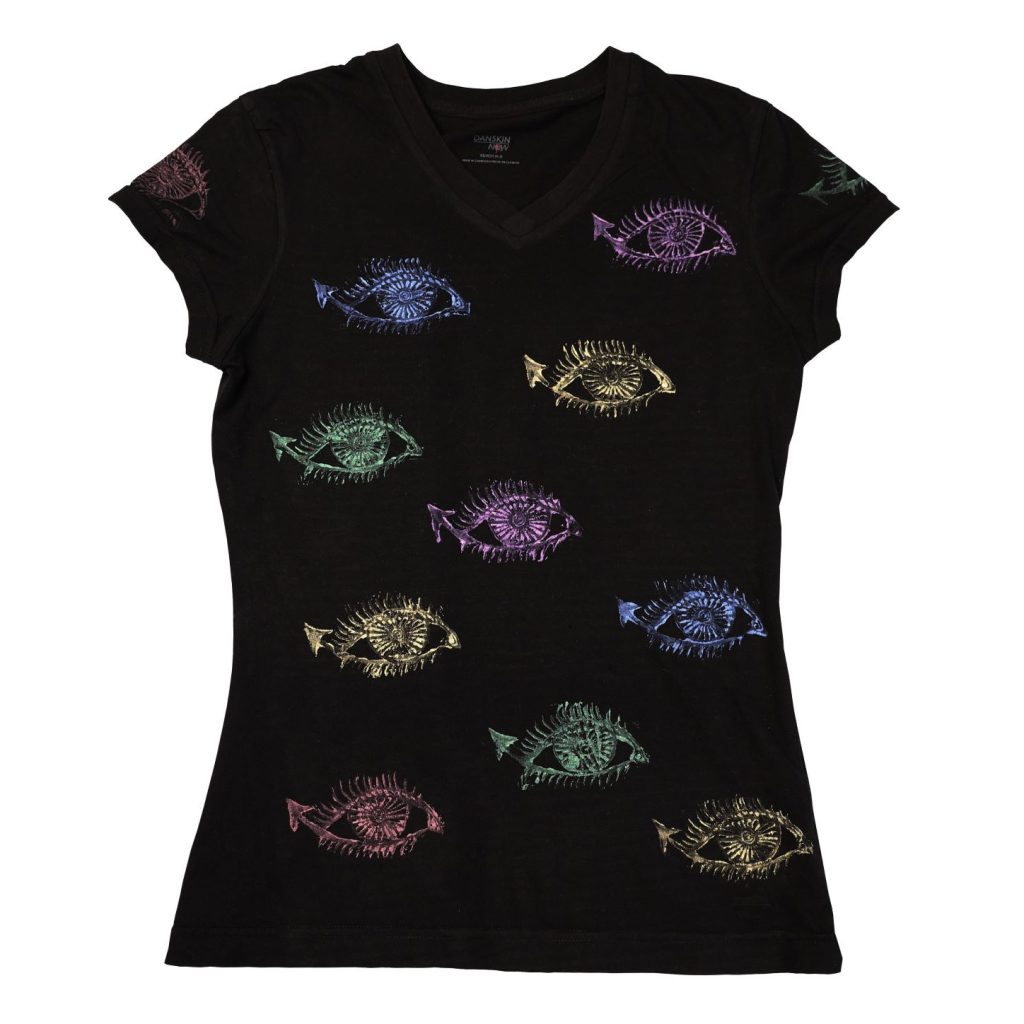
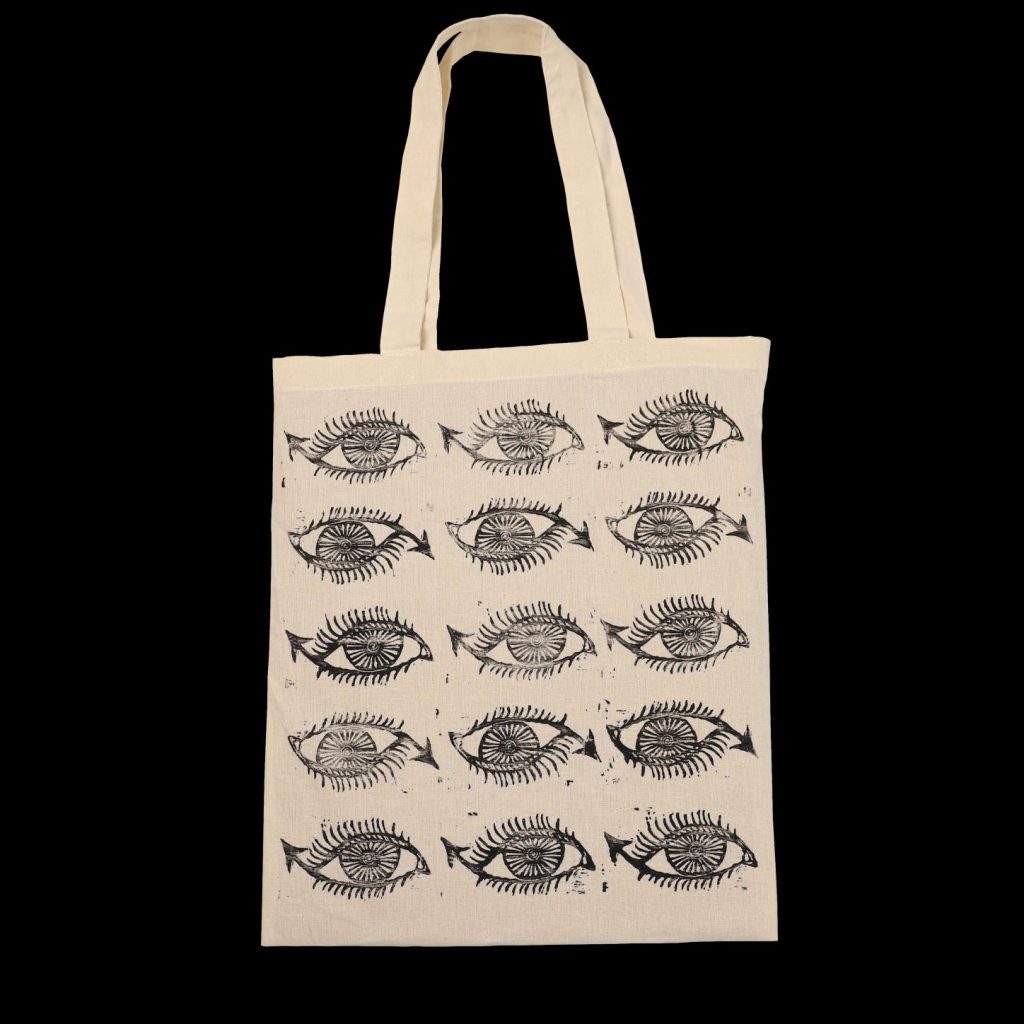
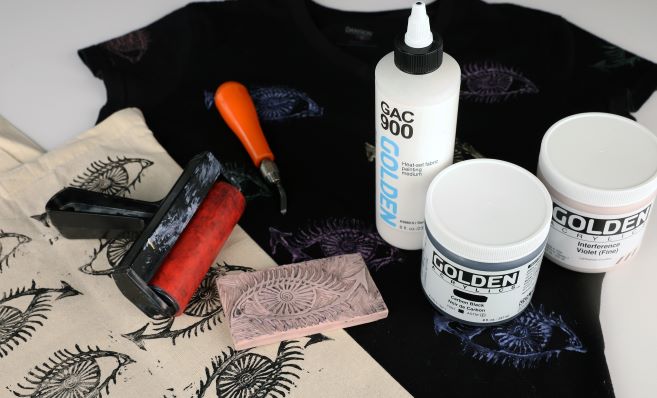


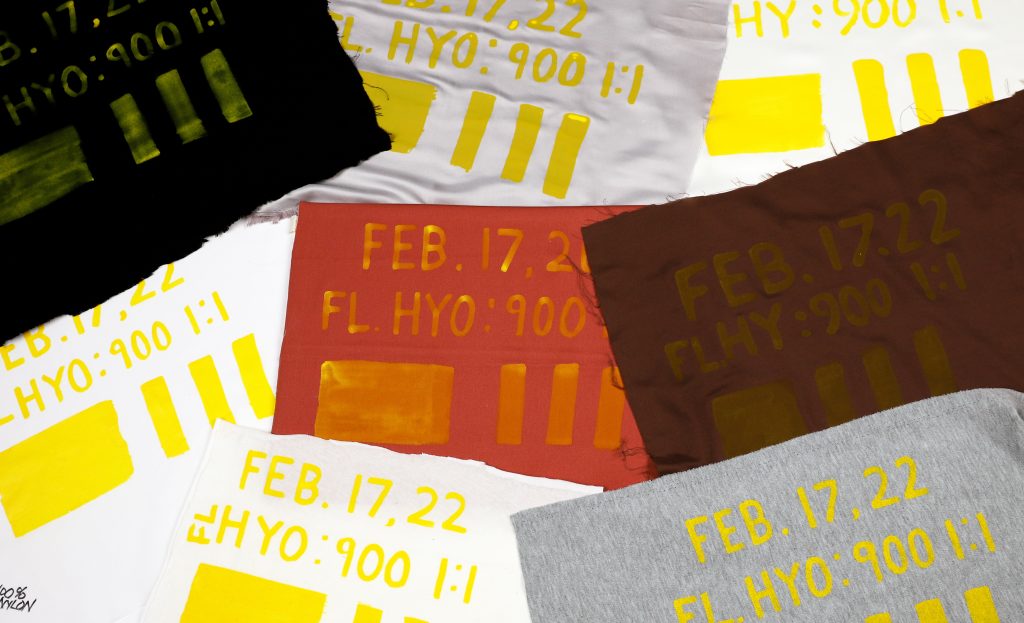
This was a really GREAT and comprehensive article! Thank you!
Thank you Meloyde. We greatly appreciate the kind words! – Mike
I love the chart with the different paints and techniques summarized! Thank-you so much for putting this all together for us 🙂
I’ve even printed the chart off and added my own notes!
Thank you! We are a big believer in the helpfulness of making and keeping notes, and we are glad the chart is useful. We have two other information sheets related to GAC 900 and fabric painting. They may be found on the Golden website. Here are the links should you be interested: Fabric Applications and GAC 900 Heat-set Fabric Painting Medium. These can provide additional information should it be needed.
Really great article : ) I was curious about the golden open line and how that would last on fabric. I have been monoprinting with the open and a gel plate for a while and thought it would be fun to take that to fabric for a potential sewing project. I did a little test, and it applied thin enough that the flexibility seemed not to be a concern, but would you still add the Gac 900 to the open to help it launder better? Is the slow-drying nature not going to set well on fabric?
Hello Bailey!
Thank you for contacting us regarding the Fabric Painting Article.
This is a great question about using OPEN Acrylics. We have had other artists report that it works really well when used thinly and is allowed to properly dry before laundering the garment. Applying a thin layer of GAC 900 after monoprinting (and allowing it to dry) would be a good safe bet. GAC 900 is very thin, and can be applied with a pump spray bottle. Allow the GAC 900 to dry and heat set as per the article (either a heat press or clothes iron is likely the best route for pieces of fabric).
Contact us at [email protected] if you have any follow-up questions!
Mike at GOLDEN